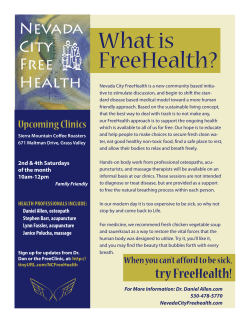
M C arshall
Marshall Medical Center 1206(d) Clinics Case Study Marshall Medical Center 105 Bed Community Hospital, located between Sacramento and South Lake Tahoe 12 Outpatient 1206(d) clinics, including a R.H.C. Service Area - 160,000 people High Medicare - Over 50%, Clinics are over 60% Nearest competitor is 25 miles West, virtually none North, East and South Gold was discovered 8 miles North but we’ve never uncovered any in our construction projects In The Beginning (1995) Major competitors moving into our service area Immediately met with all Family Medicine/Internists on medical staff Reviewed regulatory options including 1204(a), 1206(d) and 1206(l), RHC and FQHC options Results Chose 1206(d) hospital outpatient clinic Exclusion to primary care clinic requirements of the California health and safety code Highly regulated - Joint Commission Building restrictions - Title 24 and OSHPD 3 Better reimbursement Physicians formed a medical corporation and contracted with the hospital to provide services Built two compliant clinics Purchased assets First Seven Years Became safety net for physicians - competitors failed Gave a core group of physicians with which to form an IPA and contract for HMO patients Lost an average $100,000 per physician Struggled to act as a group Formed a physician/nurse practitioner model Opened practices to Medi-Cal and Medicare Developed hospitalist model using rotation of internal medicine physicians Last Nine Years Opened Marshall Peds after 5 physicians retired or left, Jan 2003 Opened Marshall Ob/GYN after our only female physician left, Jun 2004 Opened Marshall GI after 5 physicians leave over call issues, Mar 2005 Last Nine Years Opened Marshall Family Medicine in El Dorado Hills, Mar 2005 Opened Marshall Hematology and Oncology as Medicare reimbursement changed dramatically, Jan 2008 Opened Marshall Rheumatology, new specialty to our area, Feb 2008 Last Nine Years Opened Marshall Cardiology clinic after Sacramento group dissolved, Dec 2008 Currently in discussions with five specialties losing physicians and concerned about recruitment affects to their private practices and upcoming affects of federal health reform. Advantages to 1206(d) Clinics Secure structure for primary care referrals to specialty care Secure structure for specialty care referrals to hospital Maintains primary and specialty care in our community - our mission Allows access and loyalty of physicians in outlying communities to send patients Helps maintain hospital outpatient services Strong recruitment tool for bringing physicians to our community Advantages to 1206(d) Clinics Vertical integration increases hospital leverage with insurance companies Physicians available to serve on committees and projects Aligns incentives and loyalty, if the hospital does not do well, the medical groups will be effected A strong marketing presence in the community Medicare and Medi-Cal pays significantly more to hospital based clinics Maintains insurance contract access to the independent physicians Advantages to 1206(d) Clinics Gives access to Medi-Cal and indigent patients to physician care Lowers the demand upon the emergency room for nonemergent care Less restrictive in trying to support physicians to be able to serve this community for the long term Brings the group practice model to our area - including group compensation payments such as incentives Medical staff oversight for quality assurance Disadvantages to 1206(d) Clinics Offers little control of physicians We are losing $72,000 - $200,000 per physician this year Most specialties have lower losses and some are breakeven Tough to negotiate a contract with groups Very expensive office construction and staffing costs due to being hospital based clinic Independent physicians are pressuring to join and some are jealous Some write-offs due to the “72-hour”rule Disadvantages to 1206(d) Clinics Expensive to start practice through the first few years Many of the physicians we are adding are already in the community so we are not increasing access Multiple physicians groups if physicians do not want to partner Why do our 1206(d) clinics lose $ OSHPD requirements for clinic building will raise the cost of clinic space by up to 100% Marshall pays employees a higher salary than independent physicians and provides better benefits State licensing requirements such as registered nurse oversight Marshall pays all group expenses (accounting, legal, group officers, CME etc…) Clinic accepts Medi-Cal versus 0% for many in private practice Why do our 1206(d) clinics lose $ Clinic does not provide variety of profitable outpatient services in competition with the hospital FMV physician salary and benefits are determined by Western region averages which are high compared to El Dorado County physicians Clinics are used as an expansion tool and it takes a few years to fill capacity Marshall does not use the group contract for sole source contracts but requires insurance companies to offer contracts to independent physicians in the community Physician’s requests change completely when it is not their money they are spending Visits Per Provider Per Day 2010 •Family Med - 18.55 •Pediatrics - 3.63 •OB/GYN - 7.6 •Cardiology - 5 •Hem/Onc - 2 •Rheumatology - 1 15.5 18.2 13.9 15 13.5 11.3 What is Happening in the Industry? Compensation based on quality indicators Deja Vu - Hospitals are partnering with physicians and setting up clinics Gen X are looking for employment Physician incomes are falling, looking for security Health care reform AB 646, 648 & SB 726 – Start of physician employment in Ca – Complete fall of prohibition? Follow-up Questions Rvance@marshallmedical.org 530.626.2955
© Copyright 2025














